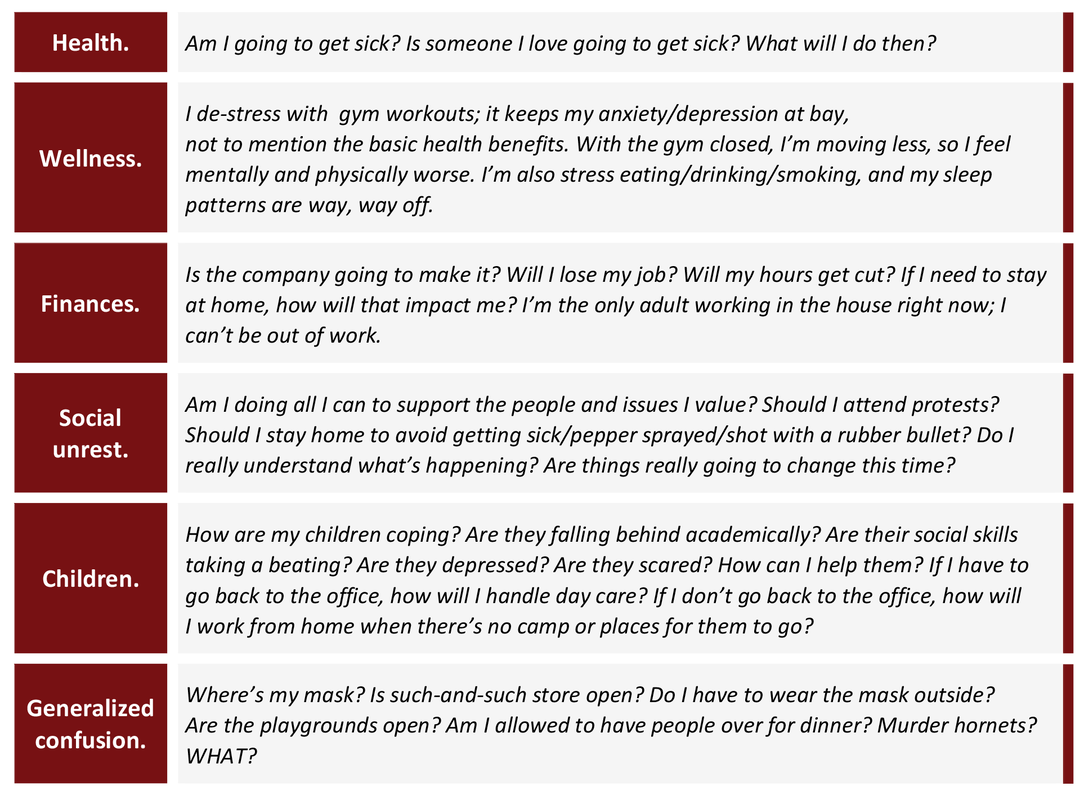Here is just a smattering of the issues that may be stressing out your teams right now. For some, it can be all of this at once. For others, it’s this on top of other mental health issues. Therapist Yessenia Guglielmi writes, “The need for mental health care is extraordinary right now ... Everyone seems to be avoiding their negative emotions and subscribing to the toxic positivity narrative in society right now. This can make people feel like failures if they are not being productive, but I want to remind people that it’s an important time to address our emotions.”¹ We are talking about mental health more now than ever, but the stigma associated with asking for help still remains, especially in the workplace where people may fear being viewed as less productive, professional, resilient, capable, adaptable, or valuable. People fear they’ll be seen differently than their counterparts and their performance and opportunities will be measured against this, which can lead to poor performance. As leaders, it’s imperative to work with your company to make the right resources available and to create a culture in which accessing those resources and/or asking for help doesn’t present a barrier or result in unconscious bias.
Empathize. These days, the word “empathy” is thrown around all the time. Showing empathy is an increasingly more critical leadership characteristic. Prudy Gourguechon sums up the value of empathy pretty well, “Without empathy, you can’t build a team or nurture a new generation of leaders. You will not inspire followers or elicit loyalty.”³ To empathize isn’t feeling sorry for someone; it’s having the ability to see someone else’s perspective, to feel along side them, to really see their situation, to share their feelings. Brené Brown’s video below does an amazing job of explaining it. Half the battle is knowing what empathy is. How do you show it? 

Communicate Options and Resources. Many companies have mental health resources and coverage of which employees aren’t even aware. Make sure you’re familiar with all the options so you can communicate them to your team. Contact your company’s Human Resources Department for an accessible list of approved and vetted resources if it isn’t already found on the company’s intranet or internet site. Offer Flexibility. In our last blog, Team Anywhere, we discussed offering some work from home options to some employees. This isn’t simply about letting them choose a long-term commitment to where they work; it’s also about managing stress and different situations that might make it difficult to get to the office. Of course, you are running a business, so it helps to have a communication plan for last-minute, unscheduled remote working days and/or shifted work hours. (You probably already have one for sick days, so leverage that.) As much as possible, you want to foster a work environment and processes that can adapt to your team members’ rapidly changing needs. In the end, that may be what we all need most: to know we are not alone and that we are valued enough to be supported as we work through things. Overall, recognize that you and your team may be struggling in ways they never were before. The more open and supportive you can be, the more you can offer flexibility and creative working solutions, the more likely your team will come to you for assistance with their situation instead of suffering in silence. The first step might just be admitting some of the ways that you’re struggling so they know they’re not alone. In the end, that may be what we all need most: to know we are not alone and that we are valued enough to be supported as we work through things. If you see yourself and your teams reflected in these struggles, now is the time to invest in skills development. Reach out to us. We’ll listen and offer you our expertise. Be sure to check back next week as we continue our series on supporting and developing managers during this transition. References
¹ Guglielmi, Y. (2020, June 10). I’m a therapist and I’m struggling with the COVID-19 pandemic, too. Retrieved from https://www.huffpost.com/entry/therapist-during-coronavirus-pandemic_n_5ed14b03c5b69b83820dfea6 ² Wingard, J. (2020, March 20). Mental health in the workplace: Leading in the COVID-19 context. Retrieved from https://www.forbes.com/sites/jasonwingard/2020/03/20/mental-health-in-the-workplace-leading-in-times-of-crisis/#786ae1956a1b ³ Gourguechon, P. (2017, December 26). Empathy is an essential leadership skill – and there’s nothing soft about it. Retrieved from https://www.forbes.com/sites/prudygourguechon/2017/12/26/empathy-is-an-essential-leadership-skill-and-theres-nothing-soft-about-it/#2b2286762b9d
0 Comments
Your comment will be posted after it is approved.
Leave a Reply. |
Archives
August 2020
BlogOur clients and the training community ask us questions and often consistent themes emerge. From making learning stick to developing skills we once assumed every employee possessed, the challenges today’s businesses face can be transformed through a strong learning culture.
Every year, the learning and development industry presents exciting developments, time-saving innovations, and new research. Solutions Arts follows and tests theories, practices, and technologies, and our clients benefit from what we learn. We value sharing what we learn and the opportunity to discuss it here on our blog.
Categories |



 RSS Feed
RSS Feed